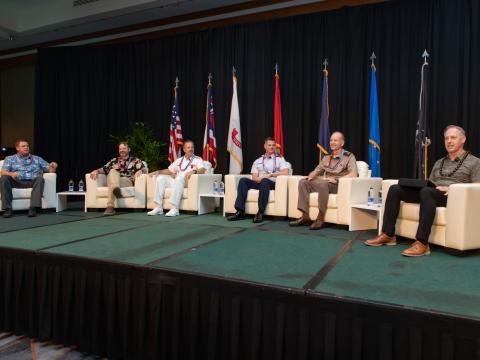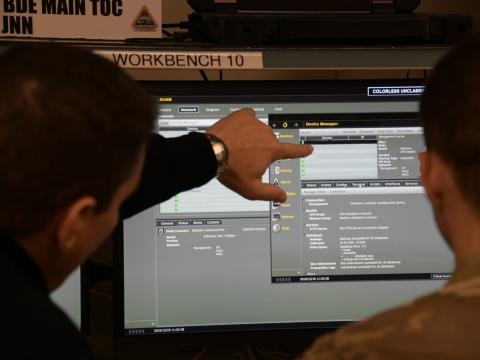Next-Generation Scheme Confronts Next-Generation Threats
Telecommunications gurus join forces to take emergency preparedness into the cyberdomain.
Communication is the lifeline during crises, and as the world transforms its communications backbone from traditional telephony to voice over the Internet, a movement is underway to expand priority services to the Internet. Many countries already have telephony priority access capabilities in place to expedite emergency services and recovery operations, and they are using these capabilities as a starting point.
Experts are calling this work the Internet Emergency Preference Scheme (IEPS). The scheme is being designed to specify a uniform set of network services that government agencies can refer to in contracting emergency use of the Internet. The goal is to make the Internet useful to emergency responders by extending priority services to next-generation packet-based networks.
The current U.S. approach is the Government Emergency Telecommunications Service, or GETS. It is a uniform set of telephony services that government agencies can refer to during a crisis. Emergency staffers access the service by calling a special telephone number and entering an identification code for authentication. During emergency situations when traffic is heavy, the system places GETS calls first. If base services are compromised, GETS services are the priority for restoration.
According to Fred Baker, a fellow at Cisco Systems, San José, California, IEPS’ principal capabilities are similar to GETS and would grant crisis personnel preferred access to voice over Internet protocol (VoIP) and data services at times when others are being denied service. If fundamental Internet access is compromised, services contracted under IEPS are restored first. Internet routers, switches and computers deployed by emergency services personnel would have a standard configuration that may be used with any IEPS network.
Baker notes that services initially contemplated in the IEPS include VoIP, video over IP, real-time whiteboard, instant messaging and e-mail, databases for queries, file transfers and World Wide Web access. When IEPS recently was expanded to include these multimedia services, the initiative was renamed the Emergency Telecommunications Service (ETS).
Because ETS services have different requirements, different plans will need to be developed for providing them. For example, voice traffic has specific delay requirements; database access has system-delay requirements; and file transfer has high throughput rates. Several technology and standards organizations are working to create standards that address these issues.
“We have technology that we have proved can work quite well during emergencies, and people are asking if there is a way to codify it and depend on it rather than relying on companies to come out of the woodwork to help,” he says.
For example, when the World Trade Center towers fell, several major telephone carriers’ telephone switches were destroyed, disabling telephone service. “What happened after that was people started using VoIP, specifically using NYSERNet facilities,” Baker shares. NYSERNet is a New York statewide high-performance academic and research network. In addition, a number of companies opened their facilities to emergency personnel and allowed them to use their VoIP systems. “Verizon dragged cables all over Manhattan and set up VoIP services as fast as it could. VoIP using existing infrastructure became a significant second telephone system, which was used for at least a week following the September 11th event.” And, on September 13, New York Governor George Pataki and former New York City Mayor Rudolph Giuliani placed a nationally televised call to President Bush using a VoIP system.
Emergency preparedness is not as much an IP question as it is an application and administration question, Baker points out. Baker is the chairman of the Internet Engineering Task Force’s (IETF’s) Internet Preparedness Working Group known as IEPREP. “We are not being asked to change IP in any way, only to give applications that use certain parameters that might affect their quality of service,” he relates. Minor changes have been proposed in several protocols to make them work well with the public-switched telecommunications network currently in use. In this context, “there is quite a bit of talk about using multiple priority levels to ensure that the right people have access when the chips are down,” he says.
Creating multiple priority levels is controversial, Baker remarks, noting that many people feel strongly that they are critical to assisting in an emergency situation. However, “there are serious questions of the wisdom of the approach,” he says. “In New York on September 11, the citizen on the scene was the person directing emergency activity, not necessarily an authorized operator. Some of the more extreme proposals in this context would disable access by other-than-authorized users, which on September 11 would have been detrimental. There are some concept-level discussions that we need to have.”
Harold Folts, a next-generation networks senior systems engineer at the National Communications Systems’ Technology and Programs Division, Arlington, Virginia, hopes to stimulate these concept-level and innovative discussions through a white paper in which he describes 14 basic functional requirements for ETS.
For example, security is among the first requirements he lists. “Security is a major concern with the evolution of packet-based networks,” he says. “Security is needed to support emergency operations. This includes threats such as spoofing, intrusion and denial of service. In addition, the identity and location of certain authorized ETS users need protection.”
Folts also addresses third-generation wireless services, noting that as emergency operations get underway, supplemental capabilities could be a significant benefit, particularly when public telecommunication resources become seriously stressed and limited.
For example, AOL handed out Blackberry handheld computers to emergency workers during September 11 recovery operations so they could use instant messenger to talk to each other. Therefore, a telecommunications infrastructure that can be readily integrated with transportable, redeployable and fully mobile facilities, such as personal communication or cellular services, would be valuable, Folts says.
But some of the most contentious issues are the political ones, Baker reveals. “In the IEPREP working group, for example, an enterprise telephone network company is working toward a converged network and wants to impose its existing telephone call policies on that infrastructure, which is reasonable for that organization,” he says. “However, the fundamental problem is that many people view networks as they are in the telephone system—as national entities. But the Internet knows nothing of borders. The Internet is a very different technology, and even if the user interface is the same, the underlying aspects will be very different. This telephone company wants its network to be the one on which every network is modeled, but other networks do it other ways, and in some countries their way may even be illegal.”
The ETS has to consider these international aspects, Folts reports in his white paper. “Disaster situations are often regional and involve multiple nations,” he says. In these cases, disaster recovery assets from multiple nations may be necessary to respond to one specific event. Many nations often provide support for recovery operations at emergency disasters outside their own borders. “ETS traffic, therefore, needs to receive favorable treatment at international gateways and within national networks providing an ETS,” he explains.
Discussions are underway, and some groups have started by working out mismatched concepts between the Internet engineering community and the emergency preparedness community, Baker observes.
“What we find ourselves working through in the IETF working group is that while the IETF is a technical organization, we have a number of people from various walks of life who are not technologists,” he says. “I am finding myself, as chair, not only trying to push the group toward workable technical solutions but also teaching them about the Internet. We have to build a common vocabulary. For example, on the Internet side we use the word transport to mean the lowest layer that runs end to end. On the telephone side, when specialists use the word transport, they’re talking about the physical patterns of bits on a wire.”
Establishing meaningful standards to make ETS viable requires a lot of dedicated cooperation and collaboration, Folts emphasizes. “ETS is multidimensional and includes many critical technical issues as well as policy, legal, regulatory and operational issues that need to be addressed. Close cooperation between government and industry will lead to a timely establishment … and deployment of ETS capabilities in the evolving telecommunication and third-generation mobile networks.”
Despite initial challenges, Baker notes that the IETF working group is making steady progress and plans to have its part of the work done by September. Other organizations are expected to follow soon, and industry experts anticipate prototyping work to validate application of newly agreed upon industry standards to begin by the end of the year.


Comments